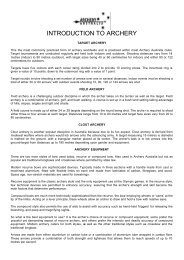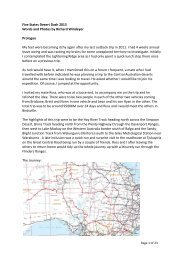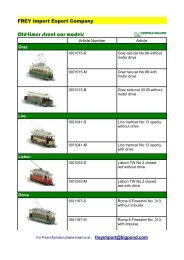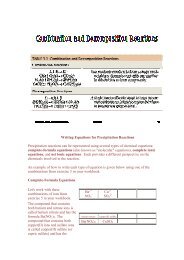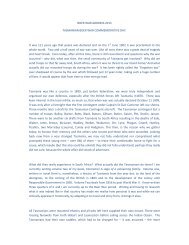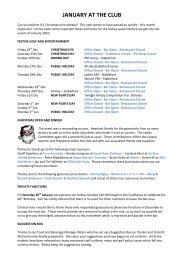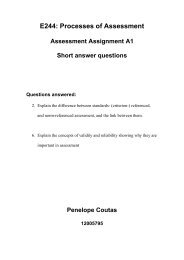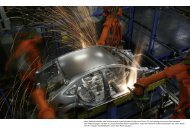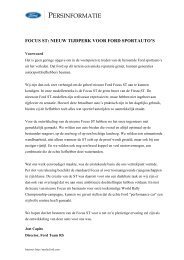Create successful ePaper yourself
Turn your PDF publications into a flip-book with our unique Google optimized e-Paper software.
<strong>2006</strong> <strong>Evinrude</strong> E-<strong>TEC</strong> <strong>Outboards</strong><br />
Two years ago <strong>Evinrude</strong> announced the release of the first E-<strong>TEC</strong> engines, ranging from 40 to 90 HP.<br />
These were revolutionary 2-stroke engines with lower emissions, better economy and less<br />
maintenance than 4-strokes. Last year the<br />
3.3 Litre V6 E-<strong>TEC</strong> engines of 200 to 250<br />
HP appeared to rave reviews of their<br />
performance, economy and quiet<br />
operation. Now for <strong>2006</strong> the 60 degree<br />
V4 and V6 engines between 115 and 200<br />
HP will arrive. The <strong>2006</strong> E-<strong>TEC</strong>s not only<br />
continue the E-<strong>TEC</strong> philosophy, but add<br />
some new features – the industry’s first<br />
electronically controlled tuned exhaust<br />
systems.<br />
Tuned exhaust systems on 2-stroke<br />
engines have been around since the early<br />
1960’s on motorcycles and go-karts where<br />
they were also very visible. The first<br />
tuned exhaust systems on production<br />
outboards happened in 1966, but these<br />
were well hidden inside the engine casings. It consisted of a short megaphone suspended inside a<br />
rectangular box and made some use of the pressure wave energy available in the exhaust gasses to<br />
increase the charge in the cylinder.<br />
3 Cylinder outboard engines also started to appear in the 1960’s for the very good reason that having<br />
120 degrees between cylinder firings just happens to provide nearly ideal spacing for a tuned exhaust<br />
system. That is the pressure wave created in the exhaust system when an exhaust port opens just<br />
happens to be at the same<br />
time as another exhaust port<br />
is closing, raising the<br />
pressure in that cylinder by<br />
pushing back some of the<br />
over scavenged fuel and air.<br />
Having higher pressure in<br />
the cylinder just after the<br />
exhaust port closes is like a<br />
little free supercharging,<br />
providing a power boost<br />
and better economy through<br />
less wastage of fuel out the<br />
exhaust.<br />
In the mid 1970’s V6<br />
outboard engines arrived<br />
and immediately power<br />
jumped by over 50HP.<br />
Although it was not very<br />
obvious at the time, one of<br />
the main reasons was<br />
exhaust tuning. V6 engines<br />
easily lend themselves to<br />
having two 3-cylinder<br />
exhaust systems neatly hidden away in the V of the engine.<br />
1966 Johnson 100 HP with early tuned exhaust<br />
system<br />
One of 2 tuned 3-cylinder<br />
systems in a V6 mid-section<br />
Iame 48 PWD Page 1 of 8
However not all engine sizes can be 3 or 6 cylinders. Engines around the 100 to 130 HP range are too<br />
big for 3 cylinders and too expensive with 6 cylinders, so 4 cylinders is much more common. 4<br />
cylinder 2-stroke engines fire every 90 degrees which makes for a nice smooth, low vibration engine,<br />
but the exhaust pressure waves travel across the exhaust system a little too early to be useful as a<br />
“plugging” pulse for another cylinder. By arranging the firing order to alternate between port and<br />
starboard sides on a V4, and keeping the port and starboard exhaust systems separate, the pressure<br />
waves then need to travel to the base of the<br />
engine then up the other side. This lengthens<br />
the wave travel path and helps to get it to<br />
arrive at the right time, but it was still not<br />
quite as good as a 3 cylinder system.<br />
Then in the mid-1990’s the “U tube”<br />
exhaust system arrived. The join between<br />
port and starboard exhaust systems now<br />
extended well down into the mid-section of<br />
the engine, increasing the exhaust pressure<br />
wave travel distance and improving the<br />
tuning.<br />
The <strong>2006</strong> <strong>Evinrude</strong> E-<strong>TEC</strong> 2 and 4 cylinder<br />
engines now add electronic control to vary<br />
the tuning at different engines speeds to<br />
provide a very broad flat torque curve.<br />
The new 60HP E-<strong>TEC</strong> is an 860cc twin<br />
cylinder engine. Two cylinders fire too far “U” tube system on a V4<br />
apart to allow the pressure wave from one<br />
cylinder to be used as a “plugging” pulse for<br />
the other cylinder, so the exhaust system utilizes a reflection of the pressure wave from the same<br />
cylinder. The tuned exhaust system in the engine’s mid-section resembles an “expansion chamber”<br />
system, but folded up to fit into the available space.<br />
A completely<br />
new, single piece<br />
lost-foam casting<br />
is required in<br />
order to fit the<br />
new larger system<br />
into the engine<br />
while still<br />
retaining room<br />
for the cooling<br />
system water<br />
pump, engine<br />
mounts and the<br />
driveshaft.<br />
Exhaust gasses<br />
enter the system<br />
at top right. The<br />
exhaust gas outlet<br />
is at bottom<br />
centre. Pressure<br />
waves travel<br />
around the U<br />
shaped loop and<br />
Exhaust<br />
from<br />
engine<br />
Gas exit<br />
to<br />
propeller<br />
Red outline shows the shape of new<br />
single piece 60 E-<strong>TEC</strong> system compared<br />
with the blue line of previous multi-piece<br />
systems<br />
Water<br />
entry<br />
point<br />
Iame 48 PWD Page 2 of 8
are reflected from the far end (upper centre on picture). The timing of the reflected wave is crucial to<br />
tuning and is determined by the distance it needs to travel and its speed. The new single-piece system<br />
has a large volume for a stronger reflection and greater length for best tuning effect at a lower RPM.<br />
In addition, water is injected into the system by the Engine Management Module (EMM) switching on<br />
a solenoid valve when it senses high throttle opening. Cool water on its way into the engine is injected<br />
by the solenoid valve, lowering the gas temperature inside the tuned section and slowing down the<br />
wave speed. Pressure waves in the exhaust gas travel at the speed of sound, about 1100 kph in the<br />
atmosphere at room temperature, but in the exhaust gas where temperatures get to 500C+ it can be<br />
1500 kph, so cooling the<br />
gas temperature has a<br />
large effect on the timing<br />
of the pressure waves and<br />
therefore the engine<br />
speed where the exhaust<br />
tuning works best.<br />
The EMM monitors<br />
throttle opening and<br />
RPM, and when the<br />
throttle opening is above<br />
80% water is injected<br />
between 2500 and 4500<br />
rpm. The result?<br />
Between 3500 and 4500<br />
RPM, at full throttle,<br />
power is increased by<br />
around 5 HP or more than 10%. Above 4500 rpm the system is dry to get the fastest pressure wave<br />
travel for best power at high RPM.<br />
New V4 and V6 “Small Block” E-<strong>TEC</strong>s<br />
<strong>2006</strong> also sees the long awaited release of the 1.7 Litre V4 and 2.6 litre V6 E-<strong>TEC</strong> models, with<br />
outputs between 115 and 200 HP. These new engines now fill the gaps in the E-<strong>TEC</strong> range so there’s<br />
now a full range from 40 to 250 HP. To enhance quality and durability, E-<strong>TEC</strong> models use many<br />
common components across the model range. The 40 to 200 HP range utilizes 2, 3, V4 and V6<br />
cylinder engine all with identical bore and<br />
stroke. These models use the same –<br />
• Piston rings<br />
• Crankshaft bearings<br />
• Con Rods<br />
• Cylinder heads (starboard head on<br />
V engines same as 2 or 3 cyl inline<br />
engine)<br />
• Electronic sensors for engine<br />
management<br />
• Linkages and external hardware.<br />
In addition the mid-sections, gearcases and<br />
crankshafts are shared over several<br />
models.<br />
The new V4 and V6 models from 115 to<br />
200 HP all share a 60 degree V angle and<br />
BHP<br />
70<br />
60<br />
50<br />
40<br />
30<br />
20<br />
With Water<br />
Injection<br />
2500 3000 3500 4000 4500 5000 5500 6000<br />
Iame 48 PWD Page 3 of 8<br />
RPM<br />
Without Water<br />
Injection<br />
Power output curves for the 60 HP E-<strong>TEC</strong>, with and without water<br />
injection into the exhaust system.
the same bore and stroke as previous <strong>Evinrude</strong> 60 degree V angle engines, but that’s where the<br />
similarity ends. The E-<strong>TEC</strong> models have a newly designed lost foam cast cylinder block with larger<br />
air intakes and reed valves, more cooling system area and a larger, more free-flowing exhaust system.<br />
Lost foam castings allow very complex shapes to be cast in<br />
a single piece allowing freedom from the need for many<br />
fasteners to hold several pieces together and all the room<br />
they need along with gaskets to seal the joints. The process<br />
is simple, make a cylinder block out of many small pieces<br />
of polystyrene foam glued together to get the desired shape.<br />
Coat the resulting assembly in a hard ceramic shell by<br />
dipping in a slurry solution then baking in an oven. Now<br />
support foam block and its ceramic shell in a sand box to<br />
hold its shape while you pour in the molten metal.<br />
The molten metal vapourises the foam and takes its exact<br />
shape. After it’s cooled, you vibrate the new casting to<br />
break away any remaining ceramic shell (it also cracks a lot<br />
during the cooling), then it’s ready for machining and<br />
surface coatings.<br />
The new 115 and 130 HP V4 E-<strong>TEC</strong> models also introduce<br />
an electronically controlled tuned exhaust system, but being<br />
a 4 cylinder engine it requires a different method than that<br />
describe above for the 60 HP. For best mid-range power<br />
and acceleration, the “U” tube that joins the port and<br />
starboard exhaust systems needs to be quite long, but that<br />
then detracts from peak power. So the V4 E-<strong>TEC</strong> utilises a system where the pressure wave travel<br />
path can be switched from long to short.<br />
For best power below 4500 RPM, the “plugging” pulse travel needs to be long, in the order of about<br />
80 cm. A “U” shaped passage is provided inside the engine’s mid-section to get the required length. A<br />
pair of mechanical valves in the exhaust are moved by an electric motor controlled by the engine’s<br />
EMM. With the valves in the open position, waves travelling from one side of the engine to the other<br />
must travel the<br />
longest distance,<br />
arriving at the right<br />
tune for best tuning<br />
effect between<br />
3500 and 4500<br />
rpm. This<br />
improves midrange<br />
torque and<br />
economy at<br />
cruising speeds.<br />
For maximum<br />
power a shorter<br />
wave path travel is<br />
better, so above<br />
4500 rpm the<br />
valves are moved<br />
to the closed<br />
position, opening a<br />
crossover port in<br />
the exhaust system.<br />
Iame 48 PWD Page 4 of 8
Now the pressure<br />
waves are forced to<br />
travel a much<br />
shorter distance,<br />
about 60 cm, so<br />
they arrive at the<br />
correct time for<br />
best tuning effect in<br />
the 4500 to 5500<br />
rpm range.<br />
These new E-<strong>TEC</strong><br />
models also share<br />
the very low<br />
emissions,<br />
excellent<br />
performance and<br />
fuel economy for<br />
which <strong>Evinrude</strong> E-<br />
<strong>TEC</strong> engines are<br />
now well known.<br />
Features brought<br />
about by the use of<br />
2-stroke engine technology combined with the revolutionary E-<strong>TEC</strong> direct injection system. Two<br />
stroke engines have twice as many power strokes for any given RPM, so making the desired power<br />
level is much easier. They also have far<br />
fewer engine components making for a<br />
smaller and lighter package which is very<br />
noticeable in boat performance. The<br />
cylinder heads is where the really big<br />
difference is obvious.<br />
On a typical V6, 4 valve, 4 stroke<br />
outboard engine there can be as many as<br />
195 individual components parts in the<br />
cylinder heads, not including the fuel and<br />
electrical system parts. On the E-<strong>TEC</strong> V6<br />
the comparable parts count is just two.<br />
Typical V6 4-stroke<br />
Of course, this relative simplicity of the 2stroke<br />
engine was, for most of the last 100<br />
years, offset by their sometimes erratic<br />
running and heavy appetite for fuel, but<br />
not any more. Direct fuel injection<br />
provides a way to inject fuel after the ports<br />
are closed so all that is lost during<br />
scavenging of the cylinder is fresh air and<br />
exhaust gas. Immediately 2-stroke engines<br />
became much cleaner and more economical, and because of their simplicity they retained their great<br />
power to weight ratio. These early direct injection systems sometimes utilised an electric solenoid<br />
type of injector to create the rapid fuel pressure pulses required to inject the fuel in the short time<br />
available. Here an electromagnet moved an iron armature to create the fuel pressure, and they were<br />
effective. They had great power, excellent economy and low emissions on a par with most 4-stroke<br />
outboards. To get better they needed a way to inject the fuel faster, although being able to inject<br />
enough fuel for each 40HP cylinder in about 5 thousandths of second probably sounds very fast<br />
indeed. However at 5000 rpm, that time represents nearly 180 degrees of crank rotation, which is<br />
about the time limit before we start to lose fuel out the exhaust again.<br />
Iame 48 PWD Page 5 of 8
The <strong>Evinrude</strong> E-<strong>TEC</strong> injector can inject all the fuel we need in less than 90 degrees of crankshaft<br />
rotation, or 2.5 thousandths of a second. It can do this because rather than a “solenoid” design, the E-<br />
<strong>TEC</strong> injector is a “voice coil” design. Like a loud speaker, the electromagnet coil is moveable (not the<br />
armature) and it reacts against a powerful stationary permanent magnets.<br />
In addition E-<strong>TEC</strong> engines<br />
operate the injectors at 55<br />
volts. The end result is<br />
faster and much more<br />
powerful injectors, with<br />
peak fuel pressures<br />
reaching over 600 psi.<br />
Being a Voice Coil design,<br />
the injector can be driven<br />
in both directions. An<br />
electrical pulse starts it<br />
moving and an opposite<br />
polarity pulse can stop it,<br />
much faster than a spring<br />
can, so now you have much<br />
greater control over how<br />
much fuel is injected and<br />
exactly when.<br />
So much control that now<br />
you can easily operate an<br />
engine in either stratified or<br />
homogeneous modes,<br />
which ever is best for the<br />
rpm and load. Stratified<br />
mode uses only a small<br />
portion of the combustion<br />
chamber, so when only a<br />
little power is required, the<br />
engine runs like it has<br />
much smaller cylinders.<br />
E-<strong>TEC</strong> injector at rest<br />
A small cone of fuel is<br />
sprayed into the<br />
E-<strong>TEC</strong> injector during fuel injection<br />
combustion chamber, close<br />
to the spark plug. The E-<strong>TEC</strong> nozzle shape and<br />
tangential flow channels allow very fine<br />
atomisation of the fuel while retaining the fuel<br />
plume in close proximity to the spark plug. The<br />
rest of the combustion chamber and cylinder<br />
contain only air and some exhaust from previous<br />
cycles.<br />
When higher power is required, homogeneous<br />
mode is used where the whole cylinder is utilised.<br />
More fuel is injected, earlier and with more force.<br />
The fuel spray is bounced off the piston crown to<br />
help spread it across the cylinder mixing it with<br />
the all the available air, and providing the<br />
maximum power available.<br />
Nozzle<br />
Iame 48 PWD Page 6 of 8<br />
Coil<br />
Magnets<br />
Close up cut-away of the E-<strong>TEC</strong> injector<br />
nozzle
High speed photograph of a stratified injection<br />
spray plume.<br />
Now that the fuel is injected directly into the cylinder, the engine’s lubricating oil can no longer be<br />
carried into the crankcase by the fuel, the old traditional 2-stroke method. E-<strong>TEC</strong> engines use a<br />
modified version of the fuel injector to inject oil into the air stream entering the crankcase where it is<br />
distributed throughout the bearing surfaces and cylinder walls. It’s easy to think the oil droplets might<br />
not mix very well with air and just cling to the<br />
walls. This series of high speed photo’s will<br />
show just how well the oil droplets are broken<br />
up into a fine mist.<br />
The arrow points to a small drop oil that is on<br />
the side wall of a reed box. This is a drop of oil<br />
that has been recirculated from the crankcase<br />
back into the intake manifold. The reed valves<br />
are starting to open, and the engine is running at<br />
5000 rpm. The next picture shows the oil<br />
droplet pulled off the wall and starting to<br />
“explode” by the air speed. The camera’s bright<br />
light shows the exploding droplet as a little<br />
white cloud. The last picture shows the oil<br />
droplet now converted to a mist so fine that is<br />
hardly reflects any light.<br />
Because there is no fuel in the air traveling into<br />
the crankcase with direct injection engines, the<br />
oil is not washed away and can remain on the<br />
bearing surfaces for many hours of engine<br />
operation. E-<strong>TEC</strong> engines have a warning<br />
mode where if oil pressure is lost for any<br />
reason, the rpm is brought back to 1200, where<br />
the engine is capable of running up to 5 hours<br />
without damage.<br />
The warning system is called SAFE (Speed<br />
Adjusting Failsafe Electronics) and monitors all<br />
engine management sensors. Any engine “lifethreatening”<br />
problem, such as no oil or no<br />
cooling water, will bring the engine back to<br />
1200 rpm and signal the operator via a 30<br />
second horn and visible indication on the dash<br />
instruments. A minor intermittent problem will<br />
be recorded in EMM memory to aid the service<br />
technician, but the operator is not bothered with<br />
warning signals.<br />
The beginning of a homogeneous injection<br />
spray plume<br />
Iame 48 PWD Page 7 of 8
All <strong>Evinrude</strong> E-<strong>TEC</strong> engines 115 HP and larger are also compatible with NMEA 2000 (National<br />
Marine Electronics Association) standard for CAN Bus instruments. CAN Bus (Controller Area<br />
Network) enables the various pieces of modern electronics on board your boat, like the engine<br />
management computer, your dash instruments, your GPS and your Fishfinder to all network together<br />
and share information, and even displays.<br />
Several types of CAN Bus instruments<br />
are already available and more will<br />
follow. <strong>Evinrude</strong>’s own I-Command<br />
system combines analogue and digital<br />
displays on the same dials. The digital<br />
displays are changeable so you can<br />
display one, or more, of several<br />
possible combinations, at the press of a<br />
button. Figuring out how much fuel<br />
you have left, or how many miles you<br />
can travel on the remaining fuel is now<br />
easy.<br />
Lowrance have<br />
a different<br />
approach in<br />
their new<br />
LowranceNET<br />
LMF 400<br />
series. Here<br />
the entire<br />
instrument face<br />
is an LCD<br />
display and<br />
which feature<br />
or type of dial<br />
you have<br />
showing, or<br />
how many<br />
dials, is very flexible and easy to use. A simple push of a button can offer you up to 8 screen layouts,<br />
with the data of your choice.<br />
CAN Bus adds more features to the electronics available onboard, but surprisingly the wiring actually<br />
gets simpler. Gone is the power and ground to every gauge, plus signal wires and wires for lights.<br />
CAN Bus instruments have a<br />
single, multi-cored cable that is<br />
just “daisy chained” from one<br />
instrument to another. All<br />
instruments share the same power<br />
and signal wires, the difference is<br />
the data is sent around the<br />
networks as small “packets”, each<br />
with its own identity. For<br />
example, a packet of data about<br />
fuel flow is ignored by gauges not<br />
involved in fuel flow or economy.<br />
The NMEA 2000 standard lays<br />
down how packets of data are<br />
constructed and what “language” is<br />
used so all NMEA 2000<br />
compatible gauges can communicate.<br />
Iame 48 PWD Page 8 of 8



